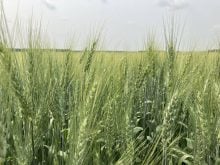Planting more canola in 2011 is a no-brainer, says a leading oilseed analyst.
“It is advisable to further expand wherever possible and where rotation requirements allow this,” Thomas Mielke, executive director of ISTA Mielke GmbH, the company that publishesOil World,told farmers attending a Farm Leadership Council meeting in Saskatoon.
Global vegetable oil demand continues to outpace supply, a situation that was exacerbated in 2010 by production problems with palm, canola, rapeseed and sunflower crops.
The supply shortfall led to a fall rally in oilseed prices. Mielke believes there could be further rise in canola prices in 2011.
Read Also

Why feds imposed EV tariffs
Moe and Kinew have a fight on their hands when it comes to eliminating the EV tariff. Canada has to worry about pissing off the U.S. and Mexico and hundreds of thousands of auto workers.
He advised growers to forward price a portion of their 2011 crop between January and April, when there could be a further price rally due to probable crop deterioration in Europe and the potential for problems with Indonesia’s palm oil crop.
This year’s grain and oilseed price rally that began with corn has been taken over by soybeans, which recently traded at a two-year high of $12 US per bushel.
Mielke expects further price increases as the fight for acres intensifies in the United States.
The U.S. corn stocks-to-use ratio is expected to be at a 15-year low at the end of this season, the world needs more wheat to make up for production declines in former Soviet Union countries and crusher demand for soybeans is overwhelming due to higher biodiesel mandates and strong food demand from China and India.
“This (available acreage struggle) is one of the bullish factors in this market,” said Mielke. “Soybeans can hardly give anything to corn.”
But the real focus is on South America, where a La Nina weather system that established its influence in August and could continue until March, 2011, has created dry conditions.
Oil World’spreliminary estimate calls for 129 million tonnes of South American production, down six million tonnes from last year.
“There is a risk that production could fall considerably more and this is already included, to a large extent, in current prices of $12 US per bu.,” said Mielke.
However, if it turns out that there is only moderate damage to the South American crop, then soybean prices are currently overvalued.
“So there is a risk of downward price reaction if we get an improvement in rainfall in the coming weeks.”
But for canola, with tight stocks and soaring demand, there is little chance prices will fall. It is the ideal oilseed to plant in 2011 because the world needs more oil and less meal, he said.
Another medium-term bullish factor for canola is that the palm industry is going to have trouble meeting demand for its oil.
The world needs palm oil production to increase at a rate of three million tonnes per year over the next decade but environmentalists have hampered acreage expansion.
Several plantations have slowed expansion of palm. Growth in acreage was halved in 2009 from the previous year, which will make it difficult to meet demand in three years time, which is how long it takes for a tree to produce.
The anticipated palm oil shortage will create yet another market opportunity for canola but it won’t likely materialize next year.
Oil Worldis forecasting a 3.3 million tonne increase in palm oil production in 2011.















